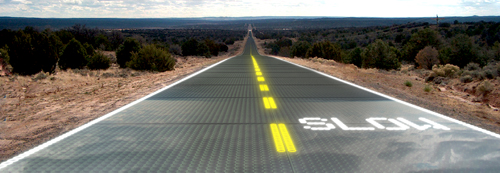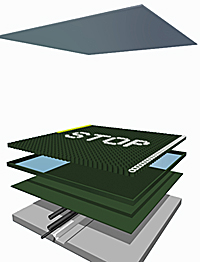
| CONNECTIONS |
IDAHO
ITD
HOME
511 TRAVEL SERVICES
IDAHO
DMV
ITD
NEWS
HIGHWAY
SAFETY
IDAHO STATE POLICE
STATE OF IDAHO
NIATT
NATIONAL
AASHTO
AAMVA
AAA of IDAHO
FEDERAL HIGHWAYS
FEDERAL AVIATION
IDAHO STATE POLICE
NHTSA
NTSB
TRB
U.S. DOT
TRANSPORTER
Archives
Milestones
Comments
Idaho
Transportation
Department
Office of Communications
P.O. Box 7129
Boise, ID 83707
208.334.8005
Fax: 208.334.8563


Can Idaho's highways become solar collectors?
 From the Idaho Business Journal
From the Idaho Business Journal
Scott Brusaw’s company has a unique idea – replace the asphalt and concrete road surfaces in Idaho and around the nation with solar panels. He envisions it as a way to provide low-cost energy, and lots of it, using a commonplace venue – the roadways we all drive on.
The U.S. DOT is willing to give it a look.
Solar Roadways, Brusaw’s start-up company from Sagle, received a $100,000 grant in late August to build a prototype roadway solar panel for testing and demonstration. Brusaw has until February 2010 to prove his idea has merit.
As the name indicates, the panels would draw energy from the sun. But it would also be an information source for drivers. The lines we are accustomed to along the highway would be coated to furnish detour warnings, “stop-ahead” alerts, and other safety related purposes.
Excess heat captured by the panels could also be used to melt snow and ice
and save millions in winter maintenance costs.
 Brusaw estimates that enough energy could be produced in one mile of solar roadway to power 500 homes, and that if all 25,000 square miles of roads, parking lots, sidewalks and driveways in the lower 48 states were covered, it would garner more – three times more – energy than we’ve ever used.
Brusaw estimates that enough energy could be produced in one mile of solar roadway to power 500 homes, and that if all 25,000 square miles of roads, parking lots, sidewalks and driveways in the lower 48 states were covered, it would garner more – three times more – energy than we’ve ever used.
There are many challenges, not the least of which is initial cost.
A mile of four-lane asphalt road would cost several hundreds of thousands of dollars for the liquid asphalt, not including production, construction, labor or equipment. However, a similar mile using solar panels would cost a little over $1.2 million, again just counting the materials.
Other obstacles would be:
-
Roads surfaces that are in a valley, lined by trees, or otherwise don’t get much sun to generate the electricity.
-
The cost of utility relocation (meaning the solar panels would have to be torn up and replaced) when future development demands.
-
Repair or replacement of panels when winter maintenance or other activities damage the existing surface.
Several hurdles exist, but just as palpable is the opportunity for change.
The Web site lists
this promising note under “Benefits”:
“We're barely keeping up with the costs of maintaining our roads and bridges as it is, and the cost of asphalt is skyrocketing. We've been using petroleum-based asphalt since the 1950s, but we won't be able to do it much longer.
New materials and technologies have to be found to replace our current archaic system. The Solar Roadway™ is an intelligent road that provides clean renewable energy, while providing safer driving conditions, along with power and data delivery.
The Solar Roadway™ will pay for itself through the generation of electricity. The same money that is being used to build and resurface asphalt roads can be used to build the Solar Roadways™.
Then, since coal-fired and nuclear power plants will no longer be needed, the costs of all electricity generation plants can also be rolled back into the Solar Roadways™. Add too the costs of power distribution systems (power poles, relay stations, etc.)”
Published 10-2-09